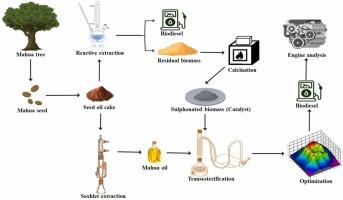使用磺化异构催化剂通过反应萃取一步合成马杜籼甲酯的可持续设计和技术经济分析
IF 5.6
1区 农林科学
Q1 AGRICULTURAL ENGINEERING
引用次数: 0
摘要
对可再生能源和环境可持续性的需求不断增长,促使人们探索生物柴油作为化石燃料的替代品。与此同时,生物精炼厂利用可持续生物质转化生产出多种增值产品。在生物柴油生产的原料中,非食用油籽马杜仲(Madhuca indica 或 Mahua)是一种可行的来源。尽管有这些优点,但在这一过程中产生的油饼被丢弃后会造成环境污染。在本研究中,在单锅反应萃取过程中产生的磺化籼稻生物质作为废弃物,经过煅烧后被用作新型异相催化剂,通过酯交换过程生产生物柴油。傅立叶变换红外光谱、气相色谱/质谱、H¹和 C¹³ NMR(核磁共振)分析对所生产生物柴油的热物理性质进行了表征。采用响应面方法(RSM)对该工艺进行了优化,最大产率为 90.01 wt%的最佳条件是温度为 70°C,甲醇与油的摩尔比为 15:1,催化剂为 3 wt%。此外,还研究了 MME15(由 15% 的籼米甲酯和 85% 的柴油混合而成)和商用柴油在直喷式 CI 发动机中的性能和排放特性,在满负荷条件下,MME15 的 CO 和 HC 排放量分别比商用柴油低 28.3% 和 18.2%。与柴油相比,MME15 的 NO 排放量高出 2.56%。技术经济学研究强调了使用磺化催化剂对籼米生物柴油进行生物炼制的效率和意义,使用 Aspen Plus 经济分析仪确定投资回收期为 3.7 年。本文章由计算机程序翻译,如有差异,请以英文原文为准。

Sustainable design of one-pot synthesis of Madhuca indica methyl ester via reactive extraction using a sulfonated heterogeneous catalyst and techno-economic analysis
The growing demand for renewable energy and environmental sustainability has led to the exploration of biodiesel as an alternative to fossil fuels. In the meantime, sustainable biomass conversion is utilized by the biorefinery to generate a wide range of value-added products. Among the feedstocks for biodiesel production, Madhuca indica or Mahua, a non-edible oilseed emerges as a viable source. Despite the advantages, the oil cake produced in this process causes environmental pollution, when discarded. In this study, the sulfonated M. indica biomass produced as waste in a one-pot reactive extraction process undergoes calcination and is utilized as a novel heterogeneous catalyst for biodiesel production through the transesterification process. The thermophysical properties of the biodiesel produced were characterized by FTIR (Fourier transform infrared spectroscopy), GC-MS (Gas chromatography/mass spectrometry), H¹ and C¹³ NMR (Nuclear Magnetic Resonance) analysis. Response Surface Methodology (RSM) was used to optimize this process, and the optimum conditions for a maximum yield of 90.01 wt% were a temperature of 70°C, a methanol to oil molar ratio of 15:1, with a catalyst of 3 wt%. Additionally, the performance and emissions characteristics of the MME15 (a blend consisting of 15 % M. indica methyl ester and 85 % diesel) and commercial diesel were studied in a direct injection CI engine in a full load condition the MME15's CO and HC emissions were 28.3 % and 18.2 % lower, respectively than those of commercial diesel. For NO emissions compared with diesel, MME15 emits 2.56 % more. The techno-economical studies highlight the efficiency and significance of the biorefinery of M. indica biodiesel by using a sulfonated catalyst and the payback period was determined as 3.7 years using the Aspen Plus Economic Analyzer.
求助全文
通过发布文献求助,成功后即可免费获取论文全文。
去求助
来源期刊

Industrial Crops and Products
农林科学-农业工程
CiteScore
9.50
自引率
8.50%
发文量
1518
审稿时长
43 days
期刊介绍:
Industrial Crops and Products is an International Journal publishing academic and industrial research on industrial (defined as non-food/non-feed) crops and products. Papers concern both crop-oriented and bio-based materials from crops-oriented research, and should be of interest to an international audience, hypothesis driven, and where comparisons are made statistics performed.
 求助内容:
求助内容: 应助结果提醒方式:
应助结果提醒方式:


